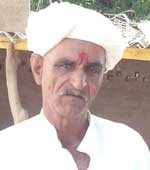Retention of Placenta (ROP) is a condition where all or part of the placenta (organ that connects the developing foetus to the uterine wall to allow gaseous, nutrient and faecal matter exchange) is left behind in the uterus after the calf’s birth. The ROP has many associated medical problems hence its earliest cure is recommended. Normally, a cow’s placenta gets expelled within 12 hours after calving, but if it does not get expelled then attention is needed. Karshanbhai has developed a unique preparation of herbal plants to deal with this problem.
Karshanbhai grinds two local plants (whole plants – name withheld due to intellectual property reasons) into very fine powder. He then adds a glass of water, boils the mixture for a couple of minutes and gives to the animal orally. After three to four hours, the placenta gets expelled from the animal’s body. During the validation trials, the expulsion of placenta in cows was observed to be within 2.43 ± 0.12 hours and within 2.38 ±0.05 hours in case of buffaloes after the administration of the medication.
In order ascertain whether the knowledge shared by Karshanbhai was known to anyone else in the village or nearby villages, a meeting was organized at his village where representatives/ herbal healers from nearby eight – ten villages were also present. During the course of discussions, no body reported the use of the said plants for ROP. Hence, based on the detailed prior art search and the community meeting, there is evidence that the knowledge possessed by Karshanbhai may be an individual knowledge and not a community knowledge.
Karshanbhai (67), a farmer, animal care taker and an expert herbal healer, has developed a very effective cure for treating retention of placenta, a common health problem affecting cattle.
Born in a farming family, Karshanbhai could only study up to class second due to financial conditions at home. As a result of the members of the family had to contribute in farming activities. His father also had good knowledge of herbs and their use in treating animals. His initiation in herbal healing was thus due to his father, and with time his interest in herbal medicines grew. He now lives with his wife, Khemiben, three sons and their families. All the sons are engaged in agriculture and animal husbandry. The family jointly owns about nine acres of land and some cattle. Their region is a dry one and irrigation facility is not available for water intensive crops, and they are dependent on canal irrigation. For this reason, the farmers grow crops like bajri, joar, raydo, wheat and arando etc. Karshanbhai has been practising herbal healing for the last twenty years. People from his village and nearby regions visit him often for consultations, especially for animals. He has been leading the efforts to maintain the village goshala for the last nineteen years.







